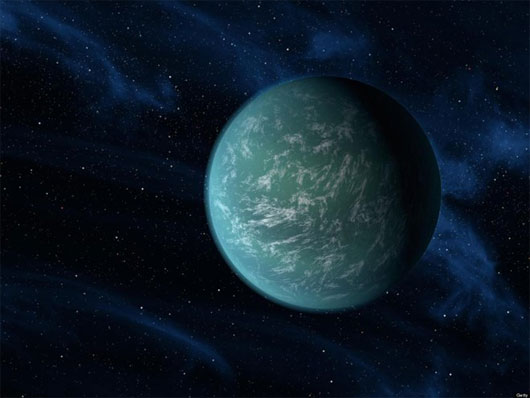Our earth is a unique planet in the universe?
Astronomers call them such super-Earths and planets so much outside our solar system. But the more you study these planets, the more experts see that our planet is an incomparable individual.
Earth-sized planets that are four times larger are thought to occupy three-quarters of the planets discovered by the US space agency Kepler.
Astronomers categorized about 3,000 planets of this type in hopes of finding life somewhere in the galaxy. But during a meeting of the American Astronomical Society in Washington on Monday, experts say that while super-Earths and mini-Jupiter are quite common, they have nothing in common with their parent planet. our.

Earth-like planet identified by NASA as Kepler-22b (Photo: NASA)
'Our solar system is very different. All the planets that Kepler has found are very strange to us , 'commented Yoram Lithwick of Northwestern University. '20% to 30% of all stars (equivalent to the sun) have these weird planets.'
The super-earth and mini-planet Jupiter are more than two and a half times the size of the earth 'always covered by a lot of gas, which is the most surprising thing,' Lithwick said. He studied about 60 such planets and found that they were formed ' very quickly after their star was born, still having a giant disk of gas surrounded. On the contrary, the earth formed much later, after the gas disk disappeared. '
Many of these planets are not only hotter than Earth, they also have a large amount of gas surrounding the rock core, which means extreme atmospheric pressure.'There will be pressure like the earth's 10 ocean bottom overlaps ,' said Geoff Marcy of California State University, Berkeley.
When asked if life could exist under such conditions, Marcy told reporters that he had to ask some biologists as biologists. In short, they are not sure.'It's not impossible,' Marcy said. 'We know very little about how life has formed and in what environments it can grow'.
Since Kepler cannot transmit data about biomass, astronomers must approach by indirect methods, such as measuring the parameters of host stars (equivalent to the sun in the solar system. ) of these planets, to see how they move due to gravity.
Larger planets often shake more due to the effects of gravity on them. David Kipping, of the Harvard-Smithsonian Center for Astrophysics, described the latest discovery from his team, a planet called KOI-314C , in a presentation entitled 'A Massive Planet like the earth is nothing like our home. '

Kepler-22b is located outside the solar system
Determined about 200 light-years from Earth, 'on a Kepler's stony range' , the planet orbits the star in its system one round every 23 days (the earth is 365 days around the sun ). The temperature in this planet is about 220 degrees Fahrenheit (104 degrees Celsius) and it covers a layer of hydrogen and helium atmosphere hundreds of kilometers thick.
The planet is one of the three planets of a mini solar system, in which celestial bodies and asteroids 'collide continuously', he told reporters. Since the planet is quite close, Kipping said he hopes further research by Hubble telescope or Hubble's telescope, James Webb Space, scheduled to operate from 2018, will bring more knowledge. about KOI-314C .
Another potential candidate for the study of super-Earths is GJ 1214b , about 40 light-years away, supposedly covering up the hordes of maya, according to Laura Kreidberg of the University of Chicago. The planet's atmosphere lacks water, methane or carbon dioxide, and clouds can be just zinc dust and sulfur chloride.
NASA's Kepler spacecraft-telescope was launched in 2009 with the mission to search for Earth-like planets by observing and transmitting data from solar systems outside us. Kepler is no longer fully operational after losing a part in the second navigation wheel of the four navigating wheels last year, but astronomers still try to use the data that Kepler transmits to Earth. .
- Discover super Earth covered with precious stones, shimmering in the universe
- The universe is full of earth
- the sleepless city as seen from space
- Marvel at the mighty universe
- Discover an earth-like planet that can have life
- Meteors bring life to Earth
- Ten strange planets of the universe
- Discovering the planet 13,000 light-years away from Earth
- 5 is mistaken for the
- Discover more planets 'brothers of the Earth' and can survive life
- Life can be born first on a diamond planet
- The universe has many planets like Earth
 Van Allen's belt and evidence that the Apollo 11 mission to the Moon was myth
Van Allen's belt and evidence that the Apollo 11 mission to the Moon was myth The levels of civilization in the universe (Kardashev scale)
The levels of civilization in the universe (Kardashev scale) Today Mars, the sun and the Earth are aligned
Today Mars, the sun and the Earth are aligned The Amazon owner announced a secret plan to build a space base for thousands of people
The Amazon owner announced a secret plan to build a space base for thousands of people